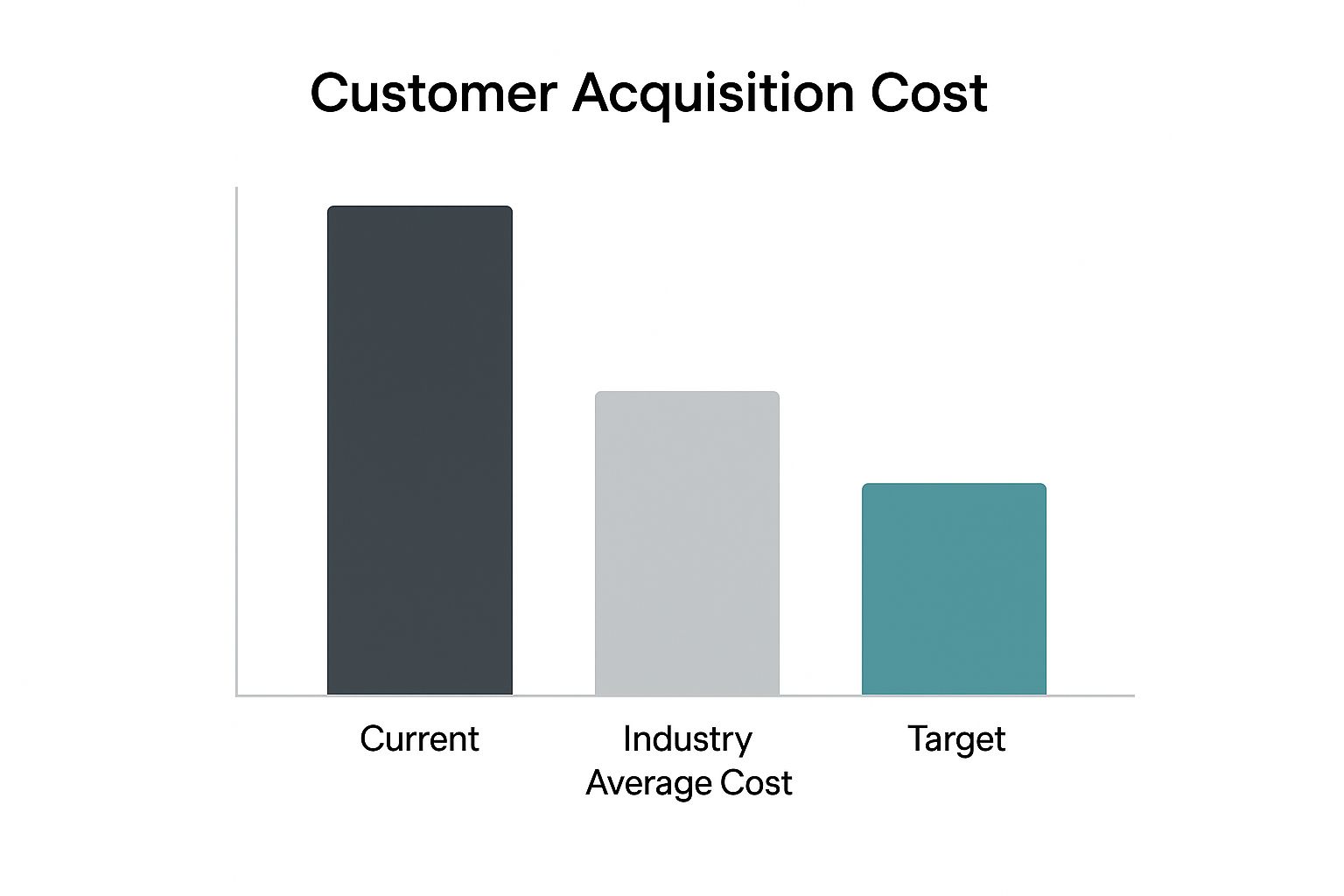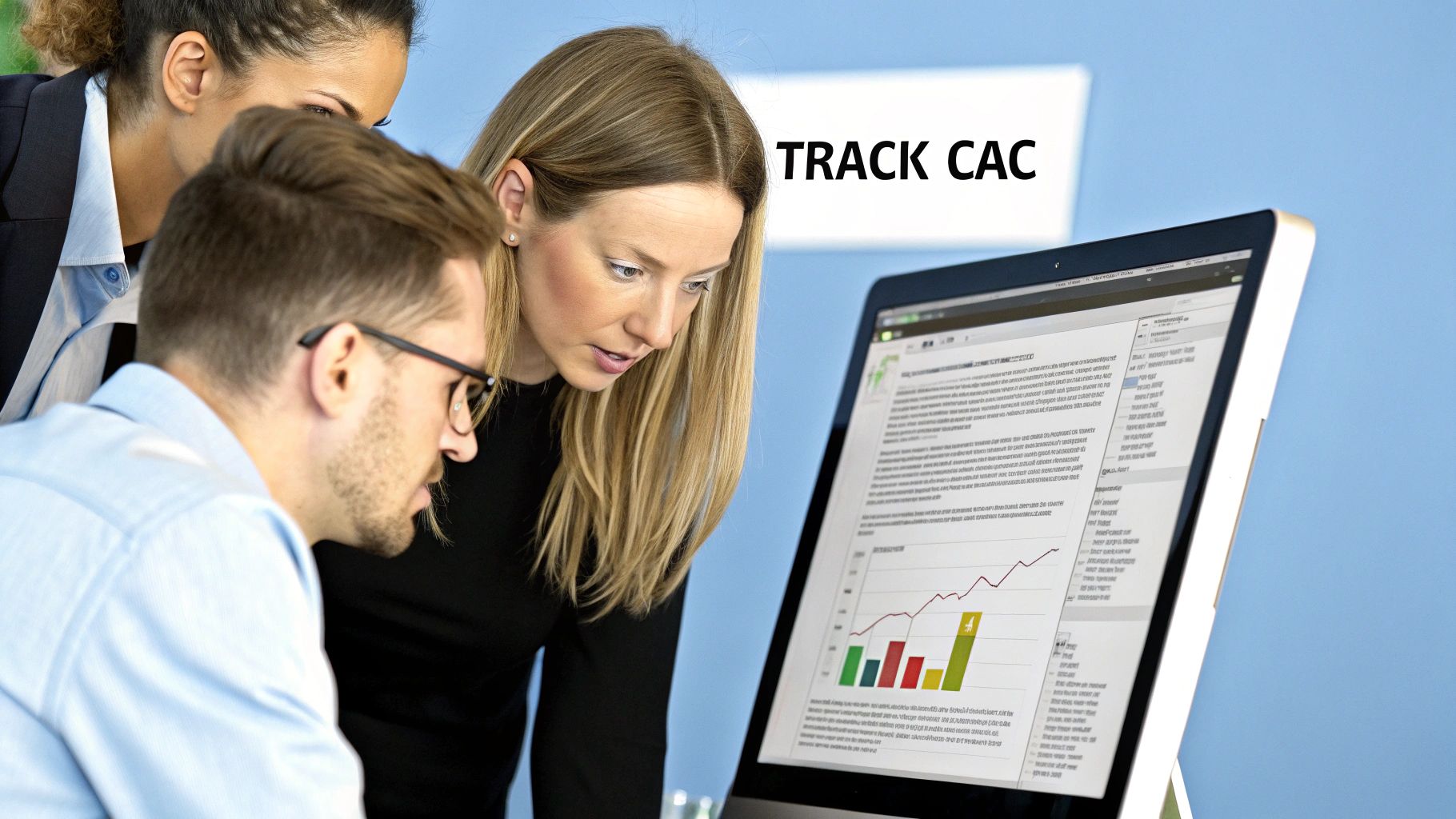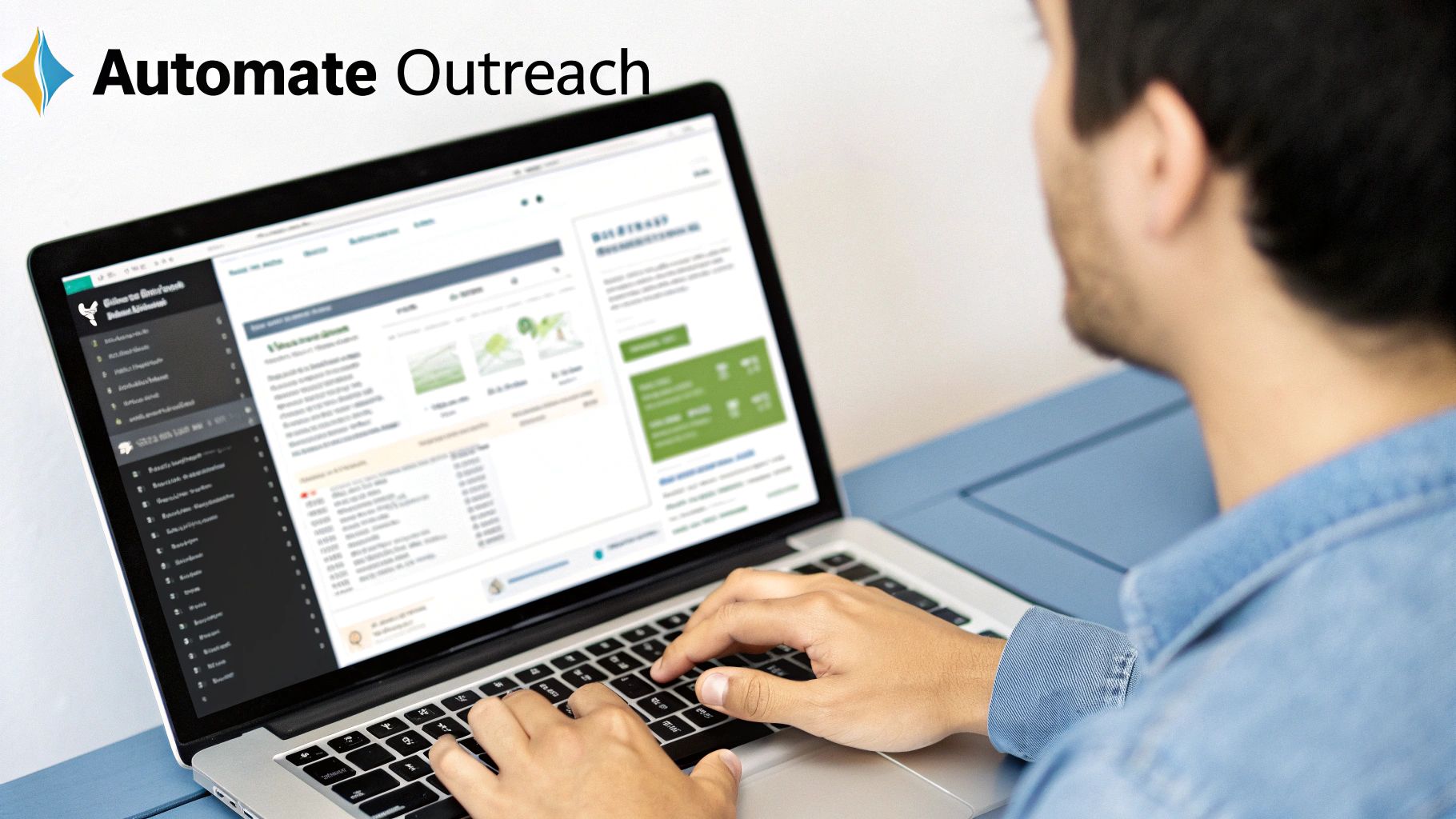Stay Updated with Everything about MDS
Thank you! Your submission has been received!
Oops! Something went wrong while submitting the form.

Chilat Doina
July 21, 2025
Before you can even think about slashing your customer acquisition costs, you need to get brutally honest with your numbers. This isn't about guesswork or gut feelings. It's about establishing a crystal-clear, data-driven baseline.
Without knowing exactly where you stand, any attempt to optimize is just a shot in the dark. Once you have this foundation, you can build a growth strategy that’s actually profitable.
So, where do we start? Before you make a single cut, you need a precise map of your current spending and performance. We're talking about surgical, informed decisions, not blind budget cuts. This whole journey kicks off with one metric that rules them all: your Customer Acquisition Cost (CAC).
In simple terms, CAC is the total cost of your sales and marketing efforts divided by the number of new customers you brought in over a set time. This isn't just your ad spend. It includes everything—tool subscriptions, agency fees, and yes, even the salaries of your marketing team. A good first step is getting a handle on your marketing workflow management software to track these expenses accurately and keep things streamlined.
Knowing your CAC is great, but it's only one piece of the puzzle. The real magic happens when you pit it against your Customer Lifetime Value (LTV)—the total revenue you can expect from a single customer over their entire journey with your brand.
The LTV:CAC ratio is your north star for profitability. It tells you if you're building a sustainable business or just spinning your wheels.
For most e-commerce brands, a healthy benchmark is an LTV:CAC ratio of 3:1 or higher. Think of it this way: for every dollar you put into acquiring a customer, you should be getting at least three dollars back.
What’s a "good" CAC? Well, it's not a one-size-fits-all number. It swings wildly from one industry to another.
For example, a Software as a Service (SaaS) business might have an average CAC hovering around $205. On the flip side, the Education sector can see acquisition costs soar to $862 because the customer journey is much longer and more considered. This is exactly why that 3:1 LTV:CAC ratio is such a vital health check for your business model.
To give you a clearer picture, I've put together a table comparing average CACs across a few different industries. Use this to get a feel for where you stand.
This table offers a comparative look at average CAC figures across various business sectors. It's a great way to benchmark your own performance and see how you stack up.
Remember, these are just averages. Your specific niche, target audience, and business model will all play a role in what a "good" CAC looks like for you.
Here's a visual that really drives this point home. It compares a hypothetical company's current CAC against the industry average and a strategic target, showing the gap that needs to be bridged.

Putting your numbers into a chart like this makes it immediately obvious where you are and where you need to go. It transforms a vague goal into a concrete, actionable target for your team.
The goal isn't just to spend less; it's to spend smarter. Establishing your baseline CAC and LTV gives you the financial map to guide every future marketing decision, turning reactive spending into proactive investment.
By truly understanding these core numbers, you're finally in a position to make strategic changes that move the needle. If you want to dive deeper, you might be interested in our guide on how to reduce customer acquisition cost with more advanced tactics.
Now that you have a solid baseline, it's time to roll up your sleeves and identify your most expensive channels. That's where the real work of optimization begins.

Let's be honest: not all of your marketing efforts are pulling their weight. Some channels are secretly burning through your budget with little to show for it, while others are absolute goldmines, bringing in high-value customers on repeat.
To really get your customer acquisition cost down, you have to go beyond a quick glance at your ad dashboard and commit to a full-funnel audit. This means tracing the entire customer journey—from the very first ad they saw to the final click that made them a paying customer.
It’s this kind of deep-dive, data-driven thinking that separates the founders who scale successfully from those who just burn cash. The goal here is to stop guessing and start making surgical decisions based on what’s actually making you money.
First things first, you need to get comfortable in your analytics platform, whether that's Google Analytics, Shopify Analytics, or another tool. The trick is to look at your acquisition channels through the lens of conversion value and cost per acquisition (CPA), not just traffic.
Traffic is a vanity metric. A channel driving thousands of visitors a month might look great on paper, but if none of them are buying, it’s a waste of resources. On the flip side, a channel with just a handful of conversions could be your most profitable if those customers have a high average order value (AOV).
I saw this exact scenario with an e-commerce brand selling high-end leather goods. They were pumping a huge chunk of their budget into Pinterest ads, and the traffic numbers were massive. Their top-of-funnel reports looked incredible. But when we dug deeper, we found their CPA on Pinterest was $120, while their AOV from that channel was only $135. After factoring in the cost of goods, they were barely breaking even. That discovery prompted a major budget reallocation and put them on a path to real, sustainable growth.
To do this for your own store, you need to segment your data and compare your main channels side-by-side. This is where the true story is.
To make it tangible, grab a spreadsheet and fill out a simple table like this for your own business. Getting a clear, comparative view of your performance is an eye-opening exercise.
In this example, Facebook Ads bring in the most customers, but look closer. SEO and Email deliver customers with a much higher AOV for a significantly lower cost. Armed with this kind of insight, you can shift your budget with confidence.
A channel's value isn't measured by the volume of traffic it generates, but by the profitability of the customers it acquires. Stop chasing clicks and start chasing profitable conversions.
This data-backed approach turns your budget from a blunt instrument into a precision tool, making sure every dollar works as hard as possible for your bottom line. For more strategies on this, our guide on how to increase ecommerce sales offers some great complementary tactics. Once you know which channels are your winners, you can double down on what works and cut the rest.
Let's be honest: paid ads can feel like a money pit. They're often the fastest way to get in front of new customers, but they can also be the single biggest reason your customer acquisition cost (CAC) is sky-high.
The goal isn't just to cut your ad budget. It's to transform that spend from a blunt instrument into a precision tool—a sharp, efficient lever for real growth. This means getting way past vanity metrics like clicks and impressions. Those feel nice, but they don't pay the bills. True efficiency comes from a relentless focus on the bottom line and squeezing every last drop of value out of each dollar.
Your best future customers probably look a lot like your best current customers. So why guess who to target? Use your own data to build powerful lookalike audiences.
Platforms like Facebook and Google let you upload a list of your highest-value customers—think people with the best lifetime value or highest average order—and their algorithms will go find more people just like them. This is one of the quickest ways I've seen to immediately improve ad relevance and cut acquisition costs.
Imagine a boutique coffee subscription brand. Instead of targeting "coffee lovers," they could create a lookalike audience from a list of customers who've been subscribers for over six months. This targets users who already show loyal behavior, not just one-time buyers, leading to a much higher quality of new customer for a lower spend.
Another killer tactic is building out sophisticated retargeting flows. Don't just blast the same ad at everyone who's ever visited your site. Get granular and tailor the message:
When you do this right, your ads stop feeling like ads and start feeling like helpful, personal reminders. That's when conversion rates really start to climb.
You can't hope to lower your CAC without a disciplined testing process. Guesswork is expensive; data is cheap. The mission is to A/B test every single element of your campaigns to find the winning formula.
The most successful advertisers aren't always the most creative ones. They're the most rigorous testers. They let the data, not their ego, tell them what actually works.
So, what should you be testing? Start with the big levers and work your way down.
Each winning test is an incremental gain. But those small wins stack up over time, creating a massive reduction in your overall CAC.
It's also critical to know where you stand. Customer Acquisition Cost (CAC) can vary wildly from one industry to the next, all based on different sales cycles and customer values.
For example, B2B sectors like IT & Managed Services might have an average CAC around $454, while something like Legal Services can hit $749 per customer. These numbers, detailed in this customer acquisition cost data breakdown, show that high-value, complex sales naturally require a bigger investment.
Knowing this context helps you set realistic goals and, more importantly, use smarter bidding strategies. Stop optimizing your campaigns for clicks or traffic—those are top-of-funnel metrics that don't guarantee sales.
Instead, configure your campaigns to bid for conversions or a target return on ad spend (ROAS). This tells the ad platform's algorithm to hunt for users who aren't just likely to click, but who are likely to actually pull out their credit card and buy something. This single shift in focus is fundamental to making your paid advertising profitable.

Relying solely on paid advertising is like renting your traffic. The second you turn off the spend, the faucet of new customers runs dry. It’s a volatile, expensive cycle that makes profitable scaling a real challenge.
If you want to truly lower your customer acquisition cost for the long haul, you have to build organic marketing engines. Think of these as assets that work for you around the clock, bringing in customers long after you’ve put in the initial work. Channels like SEO and community building are about owning your audience, not just borrowing it.
Yes, they require an upfront investment of time and resources. But the payoff is huge: a steady, predictable stream of high-quality customers at a fraction of what you'd shell out for paid ads.
The bedrock of any solid organic strategy is getting inside your customers' heads to understand what they're searching for. This isn't just about chasing high-volume keywords; it's about digging for the specific questions and pain points that signal a real intent to buy. Your mission is to find those high-intent, low-competition gems.
Put yourself in their shoes. Long before they search for your product by name, what problem are they trying to solve?
By targeting the first two categories, you get to be the helpful expert who shows up before your competitors even enter the picture. Tools like Ahrefs or SEMrush are fantastic for this, but don't sleep on free resources. Google's "People Also Ask" box and forums like Reddit are goldmines for finding the exact phrasing your customers use.
Knowing the questions is only half the battle. Now you need to provide the absolute best answers. This means creating content that does more than just rank on Google—it has to guide the reader smoothly toward a purchase. Forget about those thin, generic blog posts. The content that genuinely lowers CAC is deep, practical, and incredibly helpful.
In my experience, three types of content work like a charm for e-commerce brands:
Your content should be so valuable that people would be willing to pay for it. When you give that level of expertise away for free, you build incredible trust and authority, making the sale feel like a natural next step.
Your most powerful—and cheapest—acquisition channel? Word-of-mouth. Happy customers don't just come back for more; they become your most passionate advocates. Building a community is how you intentionally spark and nurture this powerful force.
Just look at the financial institution Trust Bank. They rolled out a seamless and rewarding referral program and achieved an astounding 70% of new sign-ups from existing customer referrals. The result? Their customer acquisition cost plummeted to just one-seventh of the industry average.
You can ignite this in your own business:
Building these organic channels isn’t a quick fix. But it's the most reliable path to breaking free from the paid ad hamster wheel and achieving sustainable, profitable growth.

Here’s a secret weapon most growing e-commerce brands overlook in their quest to lower customer acquisition cost: it is dramatically cheaper to keep a customer than to find a new one. Focusing on retention directly slashes your blended CAC by increasing the lifetime value you get from each initial acquisition.
This is all about mastering the post-purchase experience. When you delight a customer after they’ve already paid, you’re not just securing a single sale; you’re building an asset. This shift in focus from pure acquisition to retention is what separates the good brands from the truly great ones.
The first 30 days after a customer buys from you are absolutely critical. This is your window to turn a one-time buyer into a loyal fan. This is where effective email automation becomes your best friend, creating a seamless experience that feels personal and drives repeat business.
Your first move should be to set up a killer welcome series for new customers. I'm not talking about a single "thank you" email. It's a sequence designed to reinforce their buying decision and introduce them to your brand's world.
Beyond the welcome series, smart abandoned cart reminders are essential. You have to go beyond the generic "You left something behind!" email. Segment your reminders based on cart value—maybe offer a small discount or free shipping for higher-value carts to provide that extra nudge.
A well-designed loyalty program is a powerful engine for retention. It gamifies the shopping experience and gives customers a compelling reason to choose you over a competitor. The key? Keep it simple to understand and rewarding to participate in.
Avoid overly complicated points systems that feel like doing math homework. A straightforward, tiered program often works best. For example, customers can unlock new perks like free shipping, early access to new products, or exclusive content as they spend more over time. This creates a clear path to higher status and encourages bigger, more frequent purchases.
The goal of a loyalty program isn't just to give discounts; it's to make your customers feel like valued insiders. Exclusive access and recognition are often more powerful motivators than a simple percentage off.
This feeling of being part of a club is a huge driver of long-term loyalty. When executed correctly, these programs can significantly boost repeat purchase rates, which is a core component of effective e-commerce customer retention.
Finally, you absolutely must create a powerful feedback loop. Your customers are an incredible source of insights for product improvements, new ideas, and fixing things you didn't even know were broken. Actively solicit their feedback, and more importantly, show them you’re listening.
When you implement a change based on customer suggestions—and then announce it to them—you create an unbreakable bond. They see that their voice matters, transforming them from passive consumers into active co-creators of your brand. This loop where happy customers feel heard, see improvements, and keep coming back is the ultimate way to lower your acquisition costs over the long haul.
Just remember that while this strategy works globally, the costs don't. Geographical differences can have a huge impact on your budget. For example, the average cost per mobile app install in North America is around $5.28, a stark contrast to the $0.34 in Latin America. Understanding these regional nuances is key to tailoring your marketing spend for maximum efficiency, which you can learn more about in these user acquisition cost benchmarks.
Diving into the numbers behind your marketing budget always brings up a few questions. That’s natural. The path to a lower customer acquisition cost isn't a straight line—it’s a constant process of tweaking, testing, and making smart trade-offs.
Here, I'll tackle some of the most common questions I hear from e-commerce founders. Think of this as a quick-fire round to clear up the practical queries that pop up when you're in the trenches, trying to build a profitable business.
For almost any e-commerce brand, the gold standard for a healthy Lifetime Value (LTV) to Customer Acquisition Cost (CAC) ratio is 3:1 or higher.
This isn't just a random number; it's a benchmark for sustainable growth. It signals that for every dollar you put into acquiring a new customer, you're getting at least three dollars back over their lifetime with your brand.
If your ratio starts dipping below 3:1, especially if it’s creeping toward 1:1, consider it a flashing red light. It means your marketing engine is sputtering and you’re likely burning cash on every new sale once you account for COGS and other operational costs.
But what about the other extreme? A super high ratio, like 5:1 or more, might not be the home run it seems. While it screams profitability per customer, it could also mean you're being too conservative with your marketing spend. You might be playing it too safe, leaving easy market share on the table for a more aggressive competitor to snatch up.
The real goal is finding that sweet spot. You need marketing that's profitable enough to fuel the business but aggressive enough to actually capture new customers and drive real growth. The 3:1 ratio is your north star for striking that balance.
This is a fantastic question, and the answer comes down to one thing: your brand’s typical sales cycle. Jump the gun on this, and you’ll get a skewed, inflated CAC because a chunk of your potential customers simply haven't had enough time to make a decision.
For direct-to-consumer (DTC) brands selling impulse-friendly products—think cosmetics, trendy apparel, or accessories—you can usually get a reliable read on CAC within 30 days. The journey from that first click to a purchase is pretty quick.
But if you're selling products with a longer consideration phase, like furniture, high-end electronics, or specialized equipment, you have to play the long game. For these, it’s smart to wait at least 60-90 days before you call the shots on a campaign's CAC. Your customers are doing their homework, comparing options, and maybe even saving up before they pull the trigger.
Here’s a practical way to look at it—track CAC in rolling cohorts to see the full payback picture:
Using this cohort view helps you see how a campaign’s performance truly evolves, preventing you from killing a great campaign that just needed a little more time to blossom.
Absolutely. In fact, it's one of the most powerful long-term levers you can pull to sustainably lower customer acquisition cost.
Let’s be real: SEO demands a serious upfront investment of time and resources. Whether that’s your own sweat equity or an agency’s retainer, it’s not cheap. But it works completely differently than paid advertising.
With paid ads, you’re on a treadmill. You pay for every click, every impression. The second you turn off the spend, the traffic disappears. Poof.
SEO is about building a durable asset.
Once you start ranking for valuable keywords, you create a steady, continuous stream of "free" traffic from people who are actively looking for what you sell. This fundamentally reshapes your cost structure.
Think about it: the cost to create a killer blog post or build high-quality backlinks is fixed. As that single investment brings in more and more organic customers over months and even years, you’re spreading that one-time cost across a constantly growing number of acquisitions. Your blended CAC can’t help but go down.
Over time, a strong organic presence becomes a reliable pillar of your business, reducing your dependence on the volatile and ever-more-expensive world of paid ads. It’s not a quick fix, but it's the most proven way to build a defensible, low-cost growth engine.
Navigating the world of e-commerce requires more than just great products; it demands a community of sharp, experienced peers to challenge your assumptions and accelerate your growth. At Million Dollar Sellers, we connect elite entrepreneurs who are actively building 7-, 8-, and 9-figure brands. To see how our private network can help you scale smarter and faster, explore joining the community.
Join the Ecom Entrepreneur Community for Vetted 7-9 Figure Ecommerce Founders
Learn MoreYou may also like:
Learn more about our special events!
Check Events